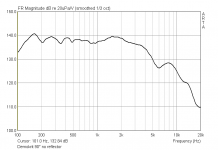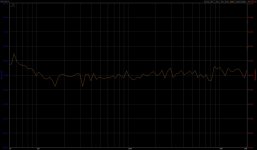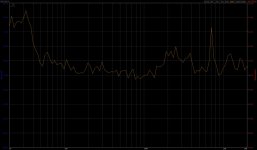Nobody says that there won't be more but I do things at my pace and in my logical order.
Would be helpful if we could see more data from different angles. Take all the time you need.
I'll post data of an elliptical reflector later.
As far as different types of reflector, which are more successful in function?
Duevel/ Canon/ B&O etc
Duevel planets seem to get good reviews but surely they also reflect some waves back at the cone.
Duevel/ Canon/ B&O etc
Duevel planets seem to get good reviews but surely they also reflect some waves back at the cone.
Sure ! That however, is a bit easier with your little box 😉
Actually I forgot to generate one diagram: 90° without reflector. Here is an older take for now (slightly different measurement setup).
Actually I forgot to generate one diagram: 90° without reflector. Here is an older take for now (slightly different measurement setup).
Attachments
Last edited:
Here's a elliptical reflector, mounted 45°. When viewed from the cone, the reflector looks like a perfect circle the same size as the piston area. The size is more or less random although the largest dimension is as big as the wavelength@1500Hz.
0° to 90° in 10° steps - box without reflector/with reflector:
Box only:
Box with elliptical reflector:
An externally hosted image should be here but it was not working when we last tested it.
0° to 90° in 10° steps - box without reflector/with reflector:
An externally hosted image should be here but it was not working when we last tested it.
An externally hosted image should be here but it was not working when we last tested it.
An externally hosted image should be here but it was not working when we last tested it.
An externally hosted image should be here but it was not working when we last tested it.
An externally hosted image should be here but it was not working when we last tested it.
An externally hosted image should be here but it was not working when we last tested it.
An externally hosted image should be here but it was not working when we last tested it.
An externally hosted image should be here but it was not working when we last tested it.
An externally hosted image should be here but it was not working when we last tested it.
An externally hosted image should be here but it was not working when we last tested it.
Box only:
An externally hosted image should be here but it was not working when we last tested it.
Box with elliptical reflector:
An externally hosted image should be here but it was not working when we last tested it.
Markus, thanks for doing all these measurements and for thus showing that a reflector like this really is a very bad idea indeed.
My guess is that distortion measurements would further underline this.
My guess is that distortion measurements would further underline this.
What do you think would cause extra distortion?
One distortion mechanism would be that sound waves from speaker to reflector are perpendicular to sound waves bounced off the reflector into the listening area. They cross and there will be intermodulation.
Another is that harmonics will be generated as a result of diffraction around the reflector.
What do you think would cause extra distortion?
He may be using the term "distortion" in the audiophile sense of the word and not the technical definition of the term. This mistake is rampant on the audio forums
Last edited:
@WithTarragon,
I use it in the sense of harmonic distortion, see above. There are a number of technical definitions of the term, btw.
I use it in the sense of harmonic distortion, see above. There are a number of technical definitions of the term, btw.
@WithTarragon,
I use it in the sense of harmonic distortion, see above. There are a number of technical definitions of the term, btw.
Well, actually distortion refers to non-linearities.
BTW, two waves "crossing" each other will not generate a non-linearity or IM distortion.
Well, actually distortion refers to non-linearities.
No, there's also linear distortion.
Well, actually distortion refers to non-linearities.
BTW, two waves "crossing" each other will not generate a non-linearity or IM distortion.
Sorry, but this is untrue in a technical sense.
It is possible to have a very non-linear amplifying stage with very low distortion. For example, I design active speakers which contain analog filters as a crossover. They should be non-linear, low distortion, and they are.
Now, you can also have amplifiers that are very linear, in that the do 20-20Khz within a fraction of a dB, but with high distortion.
In other words, linearity and distortion are very distinct concepts that cannot be mixed.
certainly it it good to keep the difference between non-flat frequency response of a linear system form being confused with a nonlinear transfer function with a power series representation (or hysterisis, ect.) the latter is usually assumed in audio when no qualification is given to the word distortion
actually nonlinear distortions give variation in fundamentals so your "precise" frequency response becomes itself a function of signal level
it is recognized as an issue in loudspeaker frequency reponse measurement
actually nonlinear distortions give variation in fundamentals so your "precise" frequency response becomes itself a function of signal level
it is recognized as an issue in loudspeaker frequency reponse measurement
Last edited:
fun looking reflector speakers, maybe Dr Geddes might comment on the irony of it appearing on a website named "Temporal Coherence"
http://www.temporalcoherence.nl/index.php?pagina=producten&lang=en
http://www.temporalcoherence.nl/index.php?pagina=producten&lang=en
fun looking reflector speakers, maybe Dr Geddes might comment on the irony of it appearing on a website named "Temporal Coherence"
Temporal Coherence
They need to sort their website out.
Interesting !
What speaker / reflector is that ? If your program can be switched to black and white because the scales are hardly legible would you please re-post the pictures ?
What speaker / reflector is that ? If your program can be switched to black and white because the scales are hardly legible would you please re-post the pictures ?
Hope this is better:
Without reflector:
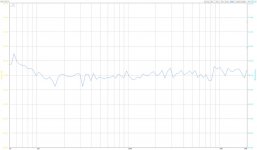
And with reflector:
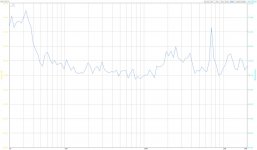
Note: one measurement starts at 20Hz, the other at 50Hz.
The speaker I used for these measurements is of my own design and for IP reasons cannot yet publish pictures, sorry, but it is nothing special in the sense that it is a two way active speaker.
As a reflector, I appropriately used Vance Dickason's "loudspeaker design cookbook'' which I had laying around.
So, these are very quick and dirty measurements, but the result is so obvious and in line with expectations, that I don't plan to spend any more time on refining them.
Without reflector:

And with reflector:

Note: one measurement starts at 20Hz, the other at 50Hz.
The speaker I used for these measurements is of my own design and for IP reasons cannot yet publish pictures, sorry, but it is nothing special in the sense that it is a two way active speaker.
As a reflector, I appropriately used Vance Dickason's "loudspeaker design cookbook'' which I had laying around.
So, these are very quick and dirty measurements, but the result is so obvious and in line with expectations, that I don't plan to spend any more time on refining them.
Thanks.
Whoever the programmer of your S/W is, would benefit from a lesson in visual contrast (dark blue on black vs. yellow on white, douh ! 🙂 )
Of course I have seen the reflections off the cone in the impulse response in my measurements but did not think further about it yet.
Most likely this will not be a killer criterion for the purpose of my speaker but I will certainly double-check it.
Anyway, good one !
Whoever the programmer of your S/W is, would benefit from a lesson in visual contrast (dark blue on black vs. yellow on white, douh ! 🙂 )
Of course I have seen the reflections off the cone in the impulse response in my measurements but did not think further about it yet.
Most likely this will not be a killer criterion for the purpose of my speaker but I will certainly double-check it.
Anyway, good one !
- Status
- Not open for further replies.
- Home
- Loudspeakers
- Multi-Way
- Acoustic reflectors and piston drivers
